3 Artificial Brains and Body [Mumm]
STUDENT LEARNING OBJECTIVES
The student will gain knowledge of the concepts and framework related to the current and future uses of human systems as related to the artificial brain and body (form factor), along with an assessment of how these autonomous systems are integrated into the world around us.
WHY ARE AUTONOMOUS SYSTEMS/ROBOTS IN THE FORM FACTOR OF HUMANS?
What is a body, and what is its purpose? Why do humans feel it is necessary to make all things conform to their relatively limited functional world? The fact that humans have opposable thumbs and can manipulate items in their environment better than a dog or a dolphin does not mean that our human environment is the most effective or efficient for getting work done or even for human happiness.
Figure 3-1: Humanoid robot in runner’s starting stance
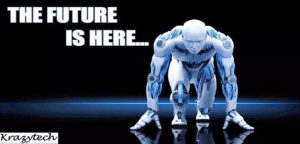
Source: (Bandakkanavar, 2021)
A limitation of the form factor for robots can become an obstacle to forward progression, as humans must unlearn their environment and learn through the lens of a robot’s point of view. Unfortunately, most of our world is set up to work within human limitations as humans must adapt to dull, dirty, or dangerous activities, yet robots thrive in these spaces.
The definition of the body when we are referring to a human is “the organized physical substance of an animal or plant either living or dead, the material part or nature of a human being” (Merriam-Webster., 2023). Yet when we examine the human counterpart in a humanoid autonomous system, the definition is “A humanoid is a robot with a human-like appearance that allows interaction with tools or environments made for humans” (Khillar, 2020). Figure 3-2 provides a quick comparison of characteristics between humanoids and robots.
Figure 3-2: Comparison Chart of Humanoid vs. Robot
| Humanoid Characteristics | Robot Characteristics |
| A humanoid is a robot with a human-like appearance that allows interaction with tools or environments made for humans. | A robot is a machine capable of executing a complex series of tasks automatically with utmost speed and precision. |
| The defining characteristics of a humanoid are to perform a complex series of physical tasks and to operate tools and manipulate objects designed for humans. | The essential characteristics of a robot include sensing movement, power, and intelligence. A robot comes in a variety of shapes and sizes. |
| The world’s first humanoid robot to be able to communicate with humans was WABOT-1. | The first programmable robot was an industrial robot named Unimate. |
Source: (Khillar, 2020)
“Robots have become humanoid robots with a human-like shape. The drive to create smart and intelligent human-like artificial machines has led to the development of humanoids” (Khillar, 2020).
The purpose and capabilities of humanoid robots vary greatly; however, they can “adapt to its surroundings and continue with its direction or command. Depending upon the size and weight, these robots have the capability of self-maintenance and an advanced feature of autonomous learning; thus, they avoid harmful situations to people, property, and themselves” (Bandakkanavar, 2021).
The challenge of choosing whether to adapt the robot or humanoid to human surroundings or allow the robot to learn and adapt its shape, form, and function to the human environment is still in debate. The issue of how to give the robot proper feedback in any given environment or situation is still in the infant stages and collecting information for feedback mechanisms is essential. How much information, what types of data, and the amount of personal privacy of an individual balance against an autonomous robot’s safe and optimal operation is still being determined.
THE SUM OF ITS PARTS, THE BODY-WHAT IS THE OPTIMUM FORM FACTOR?
Retrieving garbage from the sea can be a difficult and expensive task; typically undertaken with large machines that grab, scoop, or attempt to capture debris in similar ways to humans’ hands. However, the human form may not be the best to emulate in delicate situations, and nature might offer a better shape to mimic. So enters the robotic jellyfish. See Figures 3-3 and 3-4 for the advantages of robotic jellyfish and how they have been designed.
Figure 3-3: Jellyfish might clean the ocean one day
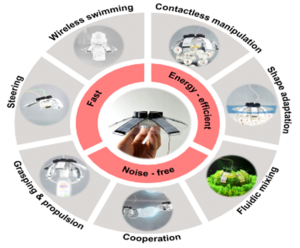
Source: (Jellyfish-like robots could one day clean up the world’s oceans., 2023)
Figure 3-4: Jellyfish might clean the ocean one day
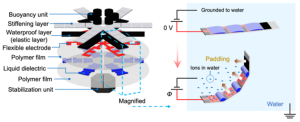
Source: (Jellyfish-like robots could one day clean up the world’s oceans., 2023)
An undertaking by the Max Planck Institute for Intelligent Systems has “discovered that the flapping propulsion system of a robotic jellyfish is not only good for movement, but it can also draw small bits of debris up from the ocean floor without any contact” (Franco, Robotic jellyfish can suck up ocean debris without touching it. , 2023b). This non-invasive movement could be leveraged to clean unique, fragile surfaces such as those found in coral reefs. (Franco, Robotic jellyfish can suck up ocean debris without touching it. , 2023b). With an eye towards nature combined with robotics, processes that date back hundreds of years are now being updated, changed, made more efficient, and sometimes even simplified.
Brewing beer is one example of a natural chemical process that is being revised. “In order to speed up and simplify the process, scientists have developed tiny BeerBots” (Coxworth, 2023).
Figure 3-5: Beerbots help fermentation
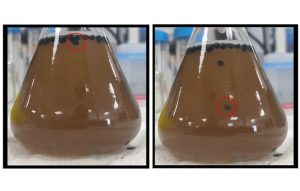
Source: (Coxworth, 2023)
These Beer Bots “release carbon dioxide gas into the air, before sinking back down again. They repeat this up-and-down process until all the sugars in the wort have been fermented” (Coxworth, 2023). Figure 3-5 illustrates BeerBots in action. BeerBots can be reused for up to three more fermentation cycles before being discarded. Professor Martin Pumera, the creator of BeerBots, admits that it would be “difficult to scale up to industrial use in its present form, so it may end up being utilized mainly by small-scale craft beer producers” (Coxworth, 2023).
Humans have had to learn to adapt to an animal-dominated world. It is “sometimes difficult to imagine how the planet we call home, with its megalopolis cities and serene farmlands, was once dominated by dinosaurs as big as buses and five-story buildings” (Reynolds, 2023).
Nature evolves as it learns to survive and thrive in its surroundings. An example is the inside of an elephant skull where there are large air sacs that allow the animal to move its massive head and heavy tusks without straining the neck muscles. The human head must be able to move similarly to the elephant, yet the human brain tends to be more delicate, and so it is protected by two layers of hard, compact bone (inner and outer tables) …known as the diploe” (Reynolds, 2023). How did animals and humans evolve in similar ways, yet be so dissimilar to each other? This is due to something known as “convergent evolution in which animals are faced repeatedly with the same problem, evolving similar – but not always identical – solutions each time” (Reynolds, 2023).
Animals evolved with vegetation, water, and different types of terrain. Then the animals had to develop with humans and additional species of animals, all fighting for the same resources. Now humans, animals, vegetation, waterways, and robots will be fighting for a balance in a resource-limited world. Robots and humans must now work through convergent evolutionary issues together, with little historical precedent to fall back on. The unknowns of true AI, quantum, hybrid networks, hybrid humans, hybrid robots, and integrated autonomous systems can harmonize humanity or result in chaos. Consider that this integration and adaptation between humans, nature, and now robots will be made with little understanding of the long-term outcomes or consequences. In an ever-changing world, convergent evolution could allow all involved to flourish or fail during some or all of these adaptations.
While considering the complexity of evolution, let us not forget that the next phase of human evolution will be in space. Recently, Rolls Royce received a £2.9-million (US$3.5-million) contract from the United Kingdom Space Agency. This contract was to develop a nuclear reactor prototype that would be part of a future lunar outpost. The energy from the reactor must be sufficient to support everything necessary within the outpost, including life support systems, communications systems, and any scientific fieldwork. The contract stipulates that the prototype must be completed by 2029 (Szondy,2023). There is no doubt that this prototype will include robotic assistance to monitor the power quality and numerous ancillary systems. The promise of a lunar outpost means that humans and robots will need to adapt to a new environment that neither are necessarily equipped to understand, work in, or be optimized for efficient harmonization.
WHY ARE AUTONOMOUS SYSTEMS/ROBOTS IN THE FORM FACTOR OF HUMANS?
When people hear the word robot, they conjure images of the AI robot Sofia or the robot Sonny from the movie iRobot. However, these human form factors are some of the least desirable as they force a machine to be subservient to a human’s world instead of allowing the machine to become the solution and the path of efficiency for humankind. Our current world is set up for humans to do the work, make the decisions, and interact with the infrastructure. However, where we need to be is just the opposite as autonomous systems begin to interact with our environments and other autonomous systems.
A hybrid of a robot and a human might be the bridge between only humans working within our human-optimized environments and when humans build more autonomous systems optimized environments, thus ending the human-driven or human-assisted work era. As noted by Wired Magazine on March 23, 2023, “For Smarter Robots, Just Add Humans autonomous machines are still too clumsy for delicate tasks. But humans can operate mechanical arms from afar, turning physical labor into remote work” (Knight, 2023). Sanctuary AI describes it as “Leveraging a blend of symbolic and neural reasoning, our autonomous control system utilizes the best of both approaches to AI while mitigating the weaknesses of each. Put another way, it is AI like it has never been done before” (Sanctuary AI-Creating human-like intelligence. , 2023). Figure 3-6 illustrates the connection between robots and human intelligence, form, and senses.
Figure 3-6: Creating the future

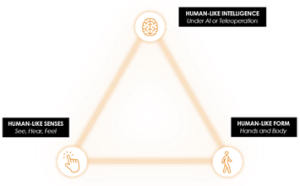
Source: (Sanctuary AI-Creating human-like intelligence. , 2023)
Sanctuary AI believes that an essential job of the future will be created in the area of remotely operating or teleoperating a physical robot Sanctuary AI “believes that this might provide a way to train robots how to perform tasks that are currently well out of their (mechanical) reach, and imbue machines with a physical sense of the world some argue is needed to unlock human-level artificial intelligence” (Knight, 2023).
The next robotic evolution for Sanctuary AI is a sixth-generation, general-purpose robot (GPR) named Phoenix™. The company aims to “shoot for the world’s first human-like intelligence in general purpose robots. Phoenix builds on some very impressive earlier work and a neat “piloted” approach to training” (Blain, 2023). Figure 3-7 provides an image and features of the Phoenix GPR.
Figure 3-7: Phoenix
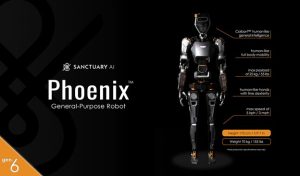
Source: (Blain, 2023)
Phoenix takes on a human form, although Sanctuary AI admits that the humanoid form “certainly isn’t the most efficient shape for a useful robot – but it’s an excellent shape for a robot that’s designed to take over as many human tasks as possible” (Blain, 2023). This is an example of evolving robots into a human environment instead of adapting the environment to accommodate the most efficient robotic design. The humanoid design allows the robot to work immediately in the infrastructure that is seen today as the “modern world is constructed mainly for bipedal creatures around a certain height, with five-fingered hands and opposable thumbs” (Blain, 2023).
The challenge of how to allow robots to operate more efficiently and effectively can sometimes be found in nature, as with the “Prehistoric sea creature-like robot can navigate, surf, crawl up onto the beach. The recently developed C-Ray uses fins to cross water, land, and ice” (Woolfolk, 2023).
Figure 3-8: Velox Robot
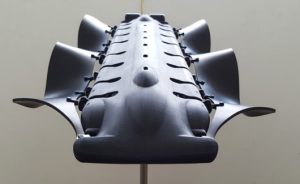
Source: (Aouf, 2019)
Taking a page from nature and allowing the robot to operate in many different environments allows the “amphibious Velox robot to use its undulating fins to swim and crawl and Velox’s versatility is due to its undulating soft fins, which sit on either side of Velox and move in a hyperbolic pattern reminiscent of a stingray or a millipede” (Aouf, 2019). See Figure 3-8 for a picture of the Velox robot.
THE ROBOTIC “EVOLUTION”
The robotics “evolution” is on pace to overtake the expectations of most investors and consumers. Consider Renuka Apte, a former Dropbox and Nvidia employee turned entrepreneur. Apte founded Clockwork, a robotics company that offers robot manicures through self-service kiosks (Clockwork Manicures in Minutes., 2023). It is reported that Clockwork has contracts with Target and XpressSpa in dozens of airports and other locations and plans to have stand-alone stores. Figure 3-9 shows a picture of the robotic manicure station.
Figure 3-9: Robotic Manicure Station
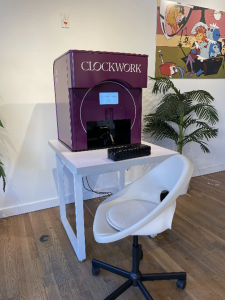
Source: (Clockwork Manicures in Minutes., 2023)
This gives Clockwork access to tens of thousands of customers daily. The company claims that “At just 10 minutes and $10, it’s self-care that’s fast and affordable” (Clockwork Manicures in Minutes., 2023).
Clockwork creates robots that offer people the ability not to be responsible for everyday tasks. Clockwork indicates they exist to “free people through smart automation— changing how they work, spend their time, and where they find peace of mind. We’re utopian dreamers from around the world who believe there is no time to waste on the mundane” (Clockwork Manicures in Minutes., 2023).
AI-THE TRAINABLE BRAIN
The human brain is still a mystery in many ways. Yet AI and other autonomous system programming profiles attempt to use the human brain patterns to create machines that can learn, think, goal-seek, and work out complex problems using critical thinking skills.
Scientists are starting from the bottom and believing they are now closer to understanding consciousness in completing the world’s “first complete, high-resolution brain map of the baby fruit fly. It’s the most complex and intricate connectome of any animal’s brain ever constructed and paves the way for a revolutionary new frontier of artificial intelligence and neuroscience developments” (Thompson, 2023).
Mapping the brain of the Drosophila Melanogaster, a type of fruit fly, took twelve years to complete. The fruit fly shares a similar biology to that of humans. This tiny insect has 3,016 neurons with 548,000 connections…” (Thompson, 2023). Researchers have been correlating the study of insect brains to humans into an actual trainable AI brain. It is easy to see that although AI is data-rich and offers the beginning of complex problem-solving; it will take a significant effort in funding, research, and development to demonstrate actual progress.
Most people think of killer robots or the adverse actions that these machines can take based on their trainable brains when discussing the concept of AI, machine learning, advanced robotics, or quantum computing in the context of autonomous systems. However, advanced robots are no different from any other technology; they can be used for good or evil or flip-flop from good and bad deeds based on the programmed missions of their human owner.
The healthcare industry benefits as robotics can assist the healthcare worker shortages and advance medicine beyond the current norm. Robots would not replace all humans; they would supplement healthcare workers as robots “could take on basic healthcare tasks to support the work of doctors and nurses may be the way of the future” (Sensing robot healthcare helpers. , 2021).
Woo Soo Kim, associate professor in the School of Mechatronic Systems Engineering, states, “The recent pandemic demonstrates the need to minimize human-to-human interaction between healthcare workers and patients… There’s an opportunity for sensing robots to measure essential healthcare information on behalf of care providers in the future” (Sensing robot healthcare helpers. , 2021).
The development of human and machine interfaces can take many forms, such as Elon Musk’s Nuerolink (Gilbert, 2019) or in “The development of a cutting-edge graphene sensor has led to the creation of an interface that is able to accurately control a robot using thought alone. The development has positive implications not only for healthcare but for a range of other industries” (McClure, 2023). See Figure 3-10 for a person using a graphene sensory device.
Figure 3-10: Male human wearing an augmented reality visor with graphene sensors attached to the back of the scalp
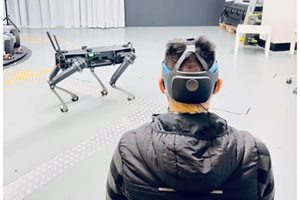
Source: (McClure, 2023)
The augmented reality visor, as shown in Figure 3-10, serves as a brain-machine interface. “Brain-machine interfaces (BMIs) allow a person to operate a device using their brainwaves. As hands-free and voice-free interfaces, BMIs hold great potential for use in robotics, bionic prosthetics, and self-driving cars” (McClure, 2023).
Nanobots target a brain cancer known as glioblastoma as it builds on previous research at the University of Toronto Robotics Institute. The Hospital for Sick Children (SickKids) research team using Midjourney took a novel approach to a possible answer to glioblastoma. They used nanorobotic scalpel swarms to shred the mitochondria of the cancer cells from the inside. The scalpel swarms were energized by using a magnetic field surrounding the malignant cells “…the tubes were made to spin, wreaking havoc to the internal structure of the cells – particularly to their mitochondria, which fundamentally provides cellular energy. The tubes acted like thousands of mini scalpels that sliced up the cancer cells from the inside (Franco, Nano-robotic scalpel swarm shreds brain cancer cells from the inside, 2023a).
Figure 3-11: Brain image highlighting the surgical area
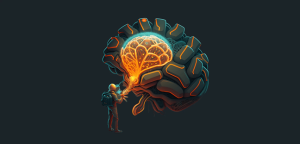
Source: (Franco, Nano-robotic scalpel swarm shreds brain cancer cells from the inside, 2023a)
Although this technique is specific to help fight glioblastoma, “the new nanobot technique could also be adjusted to work on other types of tumors…Theoretically, by changing the antibody coating and redirecting nanotubes to the desired tumor site, we could potentially have a means to precisely destroy tumor cells in other cancers” (Franco, Nano-robotic scalpel swarm shreds brain cancer cells from the inside, 2023a).
SECURING THE INSTRUCTIONS/QUANTUM REVOLUTION
In a 2023 article titled “An AI Was Trained to Detect Parkinson’s Years Before Symptoms Appeared,” David Nield discusses how the AI “Using trained layers of nodes modeled on the human brain, the tool hunts for specific chemical compounds (metabolites) in the blood, figuring out the patterns that can potentially predict the presence of disease or protect against it” (Nield, 2023).
Disease prevention is an excellent use of AI; however, what if the AI was trained to attack healthy cells or, on command, kill the host?
Most, if not all, robots/humanoids/autonomous systems are connected via a link to the internet, an intranet, each other, or other systems. These autonomous systems are an extension of the Internet of Things (IoT) as they perform a function with a base set of instructions. Sadly, as the world is discovering, IoT devices are not being designed or built with the proper level of cyber security.
The first open-market humanoid robot was from the Chinese tech firm Xiaomi, named CyberOne, in August 2022. The robot has a starting cost of more than $100,000. The robot claims human-like properties including walking and recognizing dozens of emotions “as it interacts with humans that it encounters” (Stokel-Walker, 2022). The humanoid robot is 5’9” tall and designed to be at eye level with its human counterpart. In addition, CyberOne can “identify 85 environmental sounds, alongside the 45 human emotions that it can discover, using its AI interaction algorithm that perceives where it is in the world in three dimensions…which allows it to fully simulate human movements” (Stokel-Walker, 2022).
Tesla is not far behind in launching the sale of its robot. Elon Musk, Tesla’s Chief Executive Officer, has written that the goal was “for humanoid robots to go beyond industrial work in factories and instead to make themselves at home in the home, helping out with household tasks in a way that would be meaningful” (Stokel-Walker, 2022). Musk continued with his vision. “It is foreseeable that with the power of robots, we will create an era of extreme abundance of goods and services, where everyone can live a life of abundance,” Musk wrote. “Perhaps the only scarcity that will exist in the future is for us to create ourselves as humans” (Stokel-Walker, 2022).
All of this is exciting news. However, there does not appear to be any mention of the security protocols on board or how the AI and IoT instructions are being secured, verified, altered, or monitored. The size, shape, and uses of autonomous systems continue to evolve, and so must the security levels in these systems. Consider that “Autonomous mining trucks are a $1.6 billion market and currently account for approximately 2% percent of all mining trucks, but there is a tremendous opportunity with revenue expected to increase to $12.6 billion by 2031” (Reynolds, 2023).
Figure 3-12: A Caterpillar 550 autonomous mining truck

Source: (Reynolds, 2023)
Figure 3-12 depicts a Caterpillar 794AC mining truck equipped with CAT MineStar Command for Hauling. More than 550 CAT autonomous mining trucks are in operation.
The intended or unintended damage of an autonomous system of this size being hacked and given nefarious instructions could be devastating. Mining operations around the world are expanding their use of autonomously operated systems. An “Australian mining firm Roy Hill recently announced the expansion of its AHS by converting its fleet of 96 conventional haul trucks to driverless operation and creating the world’s largest autonomous mine” (Reynolds, 2023).
Governments and industries are working together to ensure safety. However, enterprises and governments are not moving as quickly as one would think, as there is currently “no single agency in charge of this issue nor a clear path to creating a support mechanism for future needs. Nor is there a single sensor type, defense posture, or reliable countermeasure currently in place to stop these evolving threats” (Bishop, 2023).
Once considered only science fiction, the shift in the world’s workforce to autonomous systems is now a reality.
In its many forms, quantum is an example of forward progress, without adequately recognizing the need for security before marketing a product. The “emergence of potential quantum supremacy has been predicted by 2035. This prediction has caused excitement and an inflection point for the quantum information science ecosystem. Quantum supremacy will require a strategic shift in the workforce to meet this new cross-domain capability” (Bishop, 2023).
Currently, the Institute of Electrical and Electronics Engineers (IEEE) is investigating self-healing systems through a committee known as Cyber Security for Next Generation Connectivity Systems, including developing a standard for fault-tolerant systems to the point of self-healing.
This concept is further discussed in a 2023 article in the Quantum Literacy magazine “Self-Healing Systems is a field of study that finds methods and ways on how a system, service, or product can adjust and self-heal based on various types of triggers or criteria” (Bishop et al., 2023).
This discussion is critical as “building self-healing systems will require the ability to continuously measure systems, services, or products at a sub-component level, all the while adjusting the security configurations based on observed triggers or criteria” (Bishop et al., 2023).
This line of inquiry has a goal to “explore how a system, service, or product could be dynamically protected (in a self-healing manner) based on those observed criteria” (Bishop et al., 2023).
Two researchers have shown how a Tesla — and other cars — can be hacked remotely without user interaction. A drone conducted the attack on the Tesla car (Kovacs, 2021).
The attack, dubbed TBONE, exploits “two vulnerabilities affecting ConnMan, an internet connection manager for embedded devices. A hacker who exploits the vulnerabilities can perform any task that a regular user could from the infotainment system…opening doors, changing seat positions, playing music, controlling the air conditioning, and modifying steering and acceleration modes” (Kovacs, 2021).
To secure the data in advanced computing systems that are required to allow autonomous systems to operate, manufacturers must start by linking quantum security with the ability “to explore emerging concepts of cyber and supply chain trust models while creating hybrid computing security controls models will enable a digital forensic investigation (DFI) of an alleged supply chain cybersecurity breach to be documented and properly investigated” (Bishop et al., 2023).
CONCLUSIONS
There are many different form factors for robots and autonomous systems. Robots built to operate in the human world give little thought as to how to optimize the world around the robot to allow it to perform its mission more efficiently. Robots are being built to look like humans, take on human emotions, and learn and interact in a world that has been optimized for human beings and even animals, although not autonomous systems.
The critical thinking, learning, and decision engines that are being built into autonomous systems are made by humans; thus, they will have flaws, unintended uses, and consequences. The systems’ brains will remain binary all the way. Yet, humans still struggle to understand how a human brain functions, learns best, retains, and retrieves data. This data movement is influenced by emotions driving the body and mind, not in a binary energy exchange. The security required to allow autonomous systems to flourish with minimal risk of hacking and harm to the human and environment around the designs is not in place and, at present, does not appear to be a priority to manufacturers, governing bodies, or governments. The lack of security controls should raise alarms to those conducting research and development, integrators, and the end user.
QUESTIONS
- Do you think the robotic evolution will see a day when humans no longer work a full-time job or have multiple careers in their lifetime?
- List three disruptive technologies that have altered the form factor of human systems.
- How would you design the form factor of a robotic system to make a peanut butter and jelly sandwich? Consider you might need to change the entire supply chain to take advantage of robotic efficiencies.
- Can a shape-shifting robot be used for good and evil purposes? Please give two examples.
- In the current cyber security arena, do you think an AI or quantum-driven humanoid can be secured to only run/operate on its given instructions and simplistic critical thinking skills? What level of cyber security do you think is acceptable?
REFERENCES
Aouf, R. S. (2019). Amphibious Velox robot uses undulating fins to swim and crawl. . Retrieved from dezeen.com/: https://www.dezeen.com/2019/02/07/amphibious-velox-robot-technology/
Bandakkanavar, R. (2021). The truth about Humanoid Robots. Retrieved from krazytech.com/technologies/humanoid-robots: https://krazytech.com/technologies/humanoid-robots
Bishop, J. A. (2023). Quantum Supply Chain – Cybersecurity Logistics. Quantum Literacy Magazine. . Retrieved from quantumliteracy.org/: https://quantumliteracy.org/national-quantum-literacy-magazine/
Blain, L. (2023). Sanctuary rolls out Phoenix, a Carbon-based humanoid AI labor robot. . Retrieved from newatlas.com: https://newatlas.com/robotics/sanctuary-ai-phoenix-humanoid-robot/?utm_source=New+Atlas+Subscribers&utm_campaign=9372c1c223-EMAIL_CAMPAIGN_2023_05_19_02_
Clockwork Manicures in Minutes. (2023). Retrieved from likeclockwork.com/: https://likeclockwork.com/
Coxworth, B. (2023). Bubbling “BeerBots” could boost the brewing of beer. . Retrieved from newatlas.com/science/: https://newatlas.com/science/beerbots-beer-brewing/?utm_source=New+Atlas+Subscribers&utm_campaign=49a77ebaec-EMAIL_CAMPAIGN_2023_04_26_01_35&utm_medium=email&utm_term
Defense, U. S. (2020, March 11). DOD adopts 5 principles of artificial intelligence ethics. Retrieved from Army.mil: https://www.army.mil/article/233690/dod_adopts_5_principles_of_artificial_intelligence_ethics
Downes, L. (2018, February 9). How More Regulation for U.S. Tech Could Backfire. Retrieved from Harvard Business Review: https://hbr.org/2018/02/how-more-regulation-for-u-s-tech-could-backfire
Franco, M. (2023a). Nano-robotic scalpel swarm shreds brain cancer cells from the inside. Retrieved from newatlas.com/medical/nano-robotic-scalpel-brain-cancer/?utm_source=New+Atlas+Subscribers&utm_campaign=10e825078c-EMAIL_CAMPAIGN_2023_04_28_01_: https://newatlas.com/medical/nano-robotic-scalpel-brain-cancer/?utm_source=New+Atlas+Subscribers&utm_campaign=10e825078c-EMAIL_CAMPAIGN_2023_04_28_01_
Franco, M. (2023b). Robotic jellyfish can suck up ocean debris without touching it. . Retrieved from newatlas.com/marine/robotic-jellyfish-ocean-debris/?utm_source=New+Atlas+Subscribers&utm_campaign=49a77ebaec-EMAIL_CAMPAIGN_2023_04_26_01_35&utm_med: https://newatlas.com/marine/robotic-jellyfish-ocean-debris/?utm_source=New+Atlas+Subscribers&utm_campaign=49a77ebaec-EMAIL_CAMPAIGN_2023_04_26_01_35&utm_med
Freedberg, S. J. (2021, April 23). Artificial Intelligence, Lawyers And Laws Of War. Retrieved from Breaking Defense: https://breakingdefense.com/2021/04/artificial-intelligence-lawyers-and-laws-of-war-the-balance/
Gilbert, B. (2019). Elon Musk finally took the wraps off his new brain microchip company that plans to connect people’s brains to the internet by next year. . Retrieved from www.businessinsider.com/: https://www.businessinsider.com/what-is-elon-musk-brain-chip-comp
Green, L. C. (1998). The Law of War in historical Perspective. Providence, RI: U.S. Naval War College.
Hallevy, G. (2015). Liability for Crimes Involving Artificial Intelligence Systems. Switzerland: Springer.
Hoynes, C. W. (1916). Preparedness for War and National Defense. Washington, DC: Government Printing Office.
International Committee of the Red Cross. (2022, March 19). The Geneva Conventions of 1949 and their Additional Protocols. Retrieved from The International Committee of the Red Cross: https://www.icrc.org/en/doc/war-and-law/treaties-customary-law/geneva-conventions/overview-geneva-conventions.htm
Jellyfish-like robots could one day clean up the world’s oceans. (2023). Retrieved from is.mpg.de/news/quallenahnliche-roboter-konnten-eines-tages-die-weltmeere-saubern: https://is.mpg.de/news/quallenahnliche-roboter-konnten-eines-tages-die-weltmeere-saubern
Khillar, S. (2020). Difference Between Humanoid and Robot. . Retrieved from www.differencebetween.net/technology/difference-between-humanoid-and-robot/: http://www.differencebetween.net/technology/difference-between-humanoid-and-robot/
Kingston, J. K. (2018). Artificial Intelligence and Legal Liability. Ithaca, NY: Cornell University ARXIV.
Klare, M. T. (2019). Autonomous Weapons Systems and the Laws of War. Washington, D.C.: Arms Control Association.
Knight, W. (2023, March 23). For Smarter Robots, Just Add Humans. . Retrieved from www.wired.com/story: https://www.wired.com/story/fast-forward-for-smarter-robots-just-add-humans/
Kovacs, E. (2021). Tesla Car Hacked Remotely From Drone via Zero-Click Exploit. . Retrieved from www.securityweek.com/: https://www.securityweek.com/tesla-car-hacked-remotely-drone-zero-click-exploit/
Lu, J. (2018, June 28). The ‘Rules Of War’ Are Being Broken. What Exactly Are They? Retrieved from NPR.Org: https://www.npr.org/sections/goatsandsoda/2018/06/28/621112394/the-rules-of-war-are-being-broken-what-exactly-are-they
Marshall, M. (2009, July 7). Timeline: Weapons technology. Retrieved from New Scientist: https://www.newscientist.com/article/dn17423-timeline-weapons-technology/
McClure, P. (2023). New graphene sensors make for better brain-machine interface. . Retrieved from newatlas.com/technology/: https://newatlas.com/technology/graphene-sensor-interface-thought-controlled-robot/?utm_source=New+Atlas+Subscribers&utm_campaign=19ef55bc25-EMAIL_
Merriam-Webster. (2023). Definition of Body. (Vols. 2023). Merriam-Webster.
Middleton, C. (2018). SAP launches ethical A.I. guidelines, expert advisory panel. Retrieved from internetofbusiness.com: Middleton, C. (2018). SAP launches ethical A.I. guidelines, expert advisory panel. Retrieved from https://internetofbusiness.com/sap-publishes-ethical-guidelines-for-a-i-forms-expert-advisory-panel/
MIT Technology Review. (2018, March 12). When an AI finally kills someone, who will be responsible? Retrieved from MIT Technology Review: https://www.technologyreview.com/2018/03/12/144746/when-an-ai-finally-kills-someone-who-will-be-responsible/
National WWII Museum . (2020, June 5). Curator’s Choice: Gifts from the “Geneva Man”. Retrieved from National WWII Museum: https://www.nationalww2museum.org/war/articles/curator-kim-guise-geneva-collections
Nield, D. (2023). An AI Was Trained to Detect Parkinson’s Years Before Symptoms Appeared. Science Alert. Retrieved from www.sciencealert.com/: https://www.sciencealert.com/an-ai-was-trained-to-detect-parkinsons-years-before-symptoms-appeared?utm_source=ScienceAlert+-+Daily+Emai
Reynolds, S. (2023, May 9). This Adaptation Allowed Dinosaurs to Not Only Survive But to Dominate The Planet. . Retrieved from www.sciencealert.com/: https://www.sciencealert.com/this-adaptation-allowed-dinosaurs-to-not-only-survive-but-to-dominate-the-planet
Sanctuary AI-Creating human-like intelligence. . (2023). Retrieved from www.sanctuary.ai/: https://www.sanctuary.ai/
Selbst, A. D. (2020). NEGLIGENCE AND AI’S HUMAN USERS . Boston University Law Review, 1323.
Sensing robot healthcare helpers. . (2021). Retrieved from www.sciencedaily.com/: https://www.sciencedaily.com/releases/2021/02/210227083259.htm
Stokel-Walker, C. (2022). Science fiction as reality: Tesla joins Xiaomi in releasing first humanoid robots. . Retrieved from cybernews.com/editorial/: https://cybernews.com/editorial/tesla-and-xiaomi-humanoid-robots/
Thompson, B. (2023). Insect Brain Map a Landmark First Step in Unlocking Human Consciousness. . Retrieved from //newatlas.com/: https://newatlas.com/science/insect-brain-map-first-step-human-consciousness/?utm_source=New+Atlas+Subscribers&utm_campaign=3b13f5d3e5-EMAIL_CAMPA
United States Department of Defense. (2020, February 254). Department Of Defense Press Briefing on the Adoption of Ethical Principles for Artificial Intelligence . Retrieved from Defense.gov: https://www.defense.gov/Newsroom/Transcripts/Transcript/Article/2094162/department-of-defense-press-briefing-on-the-adoption-of-ethical-principles-for/
United States Department of Defense, Defense Innovation Board. (2019). AI Principles:. Washington, DC: United States Department of Defense.
Walch, K. (2020, January 12). Is There A Difference Between Assisted Intelligence Vs. Augmented Intelligence? Retrieved from Forbes: https://www.forbes.com/sites/cognitiveworld/2020/01/12/is-there-a-difference-between-assisted-intelligence-vs-augmented-intelligence/?sh=418b012426ab
Woolfolk, D. (2023). Prehistoric sea creature-like robot can navigate surf, crawl up onto the beach. Retrieved from www.militarytimes.com: https://www.militarytimes.com/video/2023/04/10/prehistoric-sea-creature-like-robot-can-navigate-surf-crawl-up-onto-the-beac

